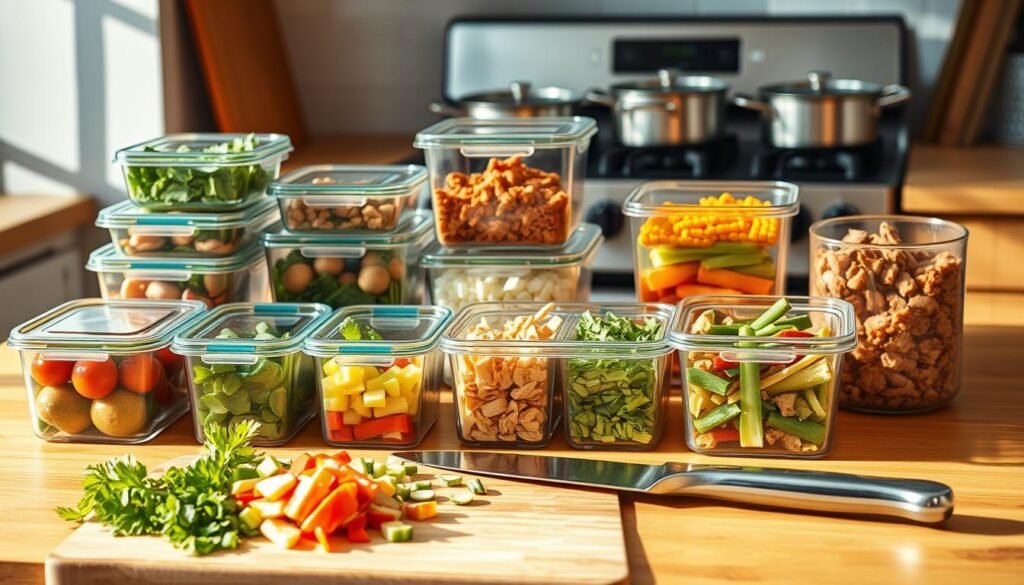Eating well without spending too much is easier than you think. With grocery prices going up, smart meal planning can save you money and help you eat better. This guide will show you how to make healthy meals that won’t break the bank.
Learn to shop better by choosing seasonal produce and comparing prices. Avoid buying things on impulse. For instance, planning meals around weekly sales can cut costs by up to 30%. We’ll also talk about how to use ingredients in more than one meal, like turning roasted chicken into soups or salads, to reduce waste.
Cost and nutrition don’t have to mean less flavor. Making small changes, like using frozen veggies or buying grains in bulk, can make meals cheaper and more interesting. Discover how simple steps, like prepping snacks ahead or using leftovers, can lead to big savings over time.
Key Takeaways
- Plan meals around seasonal produce and store sales
- Compare unit prices and choose store brands for savings
- Prep ingredients in bulk to use across multiple meals
- Use frozen or canned items to reduce spoilage
- Transform leftovers into new dishes to cut waste
What is Budget-Friendly Meal Planning?
Starting to save money on groceries begins with smart meal planning. This method helps you manage food costs while keeping meals healthy and tasty. Say goodbye to last-minute takeout.
Definition and Importance
Budget-friendly meal planning is about planning your meals with affordable ingredients you already have. It’s different from random shopping trips. It focuses on three main points:
- Using pantry staples as recipe foundations
- Matching meals to store sales cycles
- Preventing spoiled ingredients through precise portioning
“Planning meals isn’t about restriction – it’s about making your dollars work harder through smart organization.”
Benefits of Meal Planning on a Budget
Choosing thrifty meal planning offers more than just saving money. It also improves your food routine in several ways:
| Aspect | Traditional Shopping | Budget Meal Planning |
|---|---|---|
| Weekly Spending | $150+ | $90-$110 |
| Food Waste | 25% thrown out | Under 10% wasted |
| Meal Quality | Relies on processed foods | Focuses on whole ingredients |
Four key benefits make this approach transformative:
- Financial control: Allocate exact amounts for proteins, produce, and pantry items
- Healthier choices: Avoid impulse buys like chips and frozen pizzas
- Time savings: Reduce daily “what’s for dinner” stress
- Customization: Adapt plans for dietary needs without overspending
Families using low-cost meal planning save $200-$300 monthly on groceries. The secret? Buying only what you’ll actually use through intentional shopping lists.
How to Get Started with Meal Planning
Ready to take control of your food budget? Start by understanding your current eating habits. Then, design a meal plan that fits your kitchen. Here are three key steps to help you succeed.
Assessing Your Current Food Habits
Begin with a pantry audit. Empty your shelves and sort items into three groups. This includes staples, perishables, and impulse buys. It shows what you actually use and what you don’t.
Track your grocery spending for 14 days. Use a spreadsheet or app to keep track. Compare your spending to the USDA’s Thrifty Food Plan benchmarks.
| Household Size | Weekly Budget (Thrifty Plan) | Average U.S. Spending* |
|---|---|---|
| 1 person | $60-$75 | $85-$110 |
| 4 people | $165-$200 | $220-$300 |
*Source: USDA 2023 data
Setting a Monthly Budget
Split your food budget into four weekly envelopes. Use 60% for essentials like proteins and veggies. Allocate 25% for pantry restocks and 15% for flexible spending. This follows smart meal planning strategies from nutrition experts.
Freeze 10% of your budget for unexpected price changes. If chicken prices go up, you can switch to eggs without worry.
Creating a Planning Template
Make a reusable weekly grid with these columns:
- Meal type (breakfast/lunch/dinner)
- Main ingredient
- Required prep time
- Leftover potential
Color-code meals that share ingredients. For example, Tuesday’s roasted veggies can become Wednesday’s soup base. This turns frugal meal prep into a fun weekly challenge.
Effective Grocery Shopping Strategies
Smart shopping habits can save you money. Here are three ways to spend less without losing quality or variety.

Stocking Up on Staples
Start with affordable basics that make many meals. Focus on:
- Dry goods: Rice, quinoa, and oats
- Proteins: Canned beans, lentils, and frozen chicken
- Essentials: Olive oil, spices, and broth
Buy these items in bulk when they’re on sale. A 20-pound bag of rice is cheaper than small packages. Keep them fresh in airtight containers.
Understanding Store Sales and Coupons
Most stores have sales for staples every 6-8 weeks. Use apps like Flipp to find digital coupons. Pro tip:
“I plan my protein purchases around weekly meat sales – last month’s discounted turkey became three different meals.”
Always check the expiration dates on discounted items. Use both store and manufacturer coupons for the best savings.
Shopping List Essentials
Make a list that changes with sales but still meets your needs:
- Seasonal fruits/vegetables (check what’s cheapest that week)
- 2-3 protein sources (combine fresh and frozen)
- Whole grains or starchy vegetables
Be ready to swap items if prices change. If zucchini is too expensive but carrots are on sale, adjust your recipes.
Choosing Budget-Friendly Ingredients
Choosing the right ingredients is key to saving money on meals. Focus on what’s in season, versatile proteins, and buying in bulk. This way, you get more for less without losing flavor or nutrition. Let’s explore how to make every ingredient count.
Seasonal Produce
Fruits and veggies in season are 30–50% cheaper than out-of-season ones. For instance, summer zucchini is $1.29/lb, but winter prices rise to $2.99/lb. Here’s a comparison chart to help plan your meals:
| Produce | In-Season Price | Off-Season Price |
|---|---|---|
| Bell Peppers | $1.49/lb (summer) | $3.99/lb (winter) |
| Apples | $0.99/lb (fall) | $2.49/lb (spring) |
| Spinach | $2.00/bunch (spring) | $4.50/bunch (summer) |
Farmers’ markets offer “ugly” produce at low prices, great for soups or smoothies. A budget-conscious shopper shared:
“I save $20 weekly by buying seasonal ‘seconds’ and freezing extras.”
Affordable Protein Sources
Eggs have 6g of protein for just $0.15 each. Canned tuna gives 20g per serving at $1.29/can. Dried lentils offer 18g per cup cooked (about $0.30/serving). Here are some economical recipe ideas:
- Breakfast egg muffins with leftover veggies
- Tuna-stuffed baked potatoes
- Lentil tacos with cabbage slaw
Economical Grains and Carbs
Buying oats, rice, and quinoa in bulk saves up to 60% compared to packaged versions. A 25-lb bag of brown rice costs $18 (about $0.07/serving) at warehouse stores. Quinoa is more affordable in 5-lb bags ($2.99/lb vs. $5.99/lb retail).
Pair these grains with seasonal veggies and proteins for balanced economical recipe ideas. For example:
- Overnight oats with frozen berries
- Fried rice using leftover proteins
- Quinoa bowls with roasted root vegetables
Meal Prep Basics for Beginners
Learning to meal prep can save you money and reduce stress. It helps you plan your meals better and spend less on groceries. Here are three key steps to get you started.
Tools and Equipment You’ll Need
Begin with the basics to cook affordably. A slow cooker or Instant Pot makes big batches of food easy. Use glass or BPA-free containers to keep food fresh and organized.
Other affordable tools include:
- Sharp knives and cutting boards for quick chopping
- Baking sheets for roasting veggies in bulk
- Measuring cups for accurate ingredient amounts
Basic Cooking Techniques
Choose methods that save time and boost flavor. Sheet-pan dinners cook everything at once. Roasting veggies like sweet potatoes and broccoli can last up to 5 days.
Here are some tips to save money:
- Boil eggs once a week for quick protein
- Cook rice or quinoa in large amounts for many meals
- Use one-pot recipes to save on cleanup
Time-Saving Tips
Prep work can cut down your kitchen time. Chop veggies right after you shop. Store them in clear containers so you remember to use them.
Get creative with leftovers:
- Use roasted chicken in tacos or salads
- Blend bananas that are too ripe into smoothies
- Freeze veggie scraps for homemade broth
Set aside 2 hours each week for prep. It will make busy days easier. These tips help you save money and time.
Sample Meal Plans on a Budget
Ready to try inexpensive meal planning? This section offers a 7-day plan and flexible options for different diets and family sizes. You’ll learn to eat well without spending too much, even with special diets or picky eaters.
One-Week Sample Meal Plan
This plan costs just $35 a week. It uses affordable items like beans, rice, and seasonal veggies. Each day’s meals are under $5, showing you can eat well without breaking the bank.
| Day | Breakfast | Lunch | Dinner | Daily Cost |
|---|---|---|---|---|
| Monday | Oatmeal + banana | Chickpea salad wrap | Vegetable stir-fry with rice | $4.80 |
| Tuesday | Yogurt + granola | Lentil soup | Black bean tacos | $4.65 |
| Wednesday | Peanut butter toast | Quinoa bowl with roasted veggies | Pasta with marinara | $4.90 |
| Thursday | Smoothie (spinach/frozen fruit) | Egg salad sandwich | Chickpea curry + naan | $4.75 |
| Friday | Hard-boiled eggs + apple | Leftover curry | Baked potatoes with toppings | $4.50 |
Variations for Dietary Preferences
Adapt these meals easily for gluten-free, vegetarian, or food allergy needs:
- Gluten-free: Use corn tortillas instead of flour, swap regular pasta for chickpea noodles
- Vegetarian: Add tofu or tempeh to stir-fries, use vegetable broth in soups
- Dairy-free: Choose coconut yogurt, nutritional yeast instead of cheese
Kid-Friendly Budget Meals
Keep costs low and please young eaters with these ideas:
- DIY taco bars with ground turkey or lentils
- Mini pizzas on whole-wheat English muffins
- Fruit-and-yogurt parfaits layered with granola
Let kids help make their meals. They’re more likely to eat what they help create. Frozen veggies are quick and often cheaper than fresh.
Utilizing Leftovers Wisely
Leftovers don’t have to be boring. With a bit of creativity, yesterday’s meals can turn into exciting dishes. This way, you save money and reduce waste. It’s all about making the most of what you have.
Creative Ways to Repurpose Meals
Here are some easy ideas to make last night’s dinner into something new:
- Shred leftover roasted chicken for tacos, salads, or quick soups.
- Mix cooked vegetables into omelets, fried rice, or pasta dishes.
- Blend overripe fruits into smoothies or bake them into muffins.
- Combine leftover grains with beans and spices for hearty veggie burgers.
Freezing Tips for Leftover Saving
Freezing helps meals last longer without losing flavor. Here’s how to do it right:
- Portion before freezing: Divide large batches into single servings for easy thawing.
- Use airtight containers or freezer bags to prevent freezer burn.
- Label items with dates and contents – most dishes stay fresh for 2-3 months.
- Freeze sauces and broths in ice cube trays for recipe-ready portions.
Want to cut down on food waste? Check out our guide on meal planning around leftovers. Use these tips with your frugal meal prep to save up to 30% on groceries each month.
Healthy Eating on a Budget
Eating well doesn’t have to cost a lot. You can make healthy meals without spending a lot. Let’s look at how to eat healthy without breaking the bank.
Nutrient-Dense Budget Choices
Choose foods that are full of vitamins and minerals but not expensive. Spinach is packed with iron and vitamins for just $1.50 a bunch. Sweet potatoes are rich in vitamins and fiber for about $0.80 a pound, cheaper than many snacks.
Other affordable superfoods include:
- Oats: Full of fiber and protein for $0.15 a serving
- Eggs: A complete protein for $0.20 each
- Lentils: A plant-based protein for $1.25 a pound
| Food | Key Nutrients | Cost Per Serving |
|---|---|---|
| Spinach | Iron, Vitamin K | $0.30 |
| Sweet Potato | Vitamin A, Fiber | $0.40 |
| Canned Tuna | Omega-3, Protein | $0.75 |
Balancing Meals with Limited Funds
Use the USDA’s MyPlate method to make balanced meals without spending too much. Divide your budget into four parts:
- Vegetables (40% of plate): Frozen mixed veggies for $1.50 a bag
- Proteins (25%): Chicken thighs for $1.99 a pound or tofu for $2.50 a block
- Grains (25%): Brown rice for $0.25 a cooked cup
- Fruits (10%): Seasonal apples or bananas for $0.30 each
Mix these foods in dishes like stir-fries or grain bowls. Pro tip: Buy whole chickens instead of pre-cut pieces for 3-4 meals from a $7 bird.
“Nutrition isn’t about perfection – it’s about making better choices most of the time.”
Use budget-friendly protein sources like beans and peanut butter. For healthy fats, choose store-brand olive oil over expensive avocado oil. Remember, water is the cheapest and healthiest drink.
Cooking in Batches
Imagine cutting your kitchen time in half while still enjoying homemade meals all week. Batch cooking is a great hack for busy households. It lets you prepare multiple meals at once. This method is perfect for those new to meal prep or looking to simplify their routine.

Benefits of Batch Cooking
Save time, money, and energy by cooking large portions of staples like grains, proteins, and soups. You’ll avoid daily cooking marathons and reduce the temptation to order takeout. Batch cooking also minimizes food waste since you’ll use ingredients efficiently.
Freezing meals in portion-sized containers ensures you always have a quick, healthy option. This approach works especially well for dishes like chili, casseroles, or curries that taste better after flavors meld. Plus, you’ll spend less on groceries by buying ingredients in bulk.
Recipes for Batch Cooking Success
Start with freezer-friendly recipes that reheat well. Lentil soup, for example, packs protein and fiber while staying cost-effective. Vegetarian chili is another crowd-pleaser—simply double the recipe and freeze half for later.
For inspiration, explore these budget batch cooking recipes designed to maximize flavor and minimize effort. Try these tips:
- Cook proteins like chicken or beans in bulk to use across multiple meals
- Roast a sheet pan of seasonal veggies for quick stir-fries or grain bowls
- Portion meals before freezing to simplify defrosting
With a little planning, you’ll turn one afternoon of cooking into a week’s worth of affordable meal prep wins. Your future self will thank you during hectic weeknights!
Incorporating Seasonal Ingredients
Seasonal ingredients are more than a trend. They’re a key to making tasty, affordable meals. By matching your meals with nature’s seasons, you get fresher tastes and save money. Let’s dive into how to use this strategy in your kitchen and wallet.
Why Seasonal Eating Saves Money and Boosts Taste
Buying produce in season can save you up to 30% compared to out-of-season. During peak times, farmers’ markets and stores are full of these items. This competition lowers prices. You’ll also enjoy:
- Deeper flavors from ripe crops
- More nutrients in fresh produce
- Less environmental harm from local sources
Smart Strategies for Seasonal Shopping
Plan your meals around these seasonal highlights to save more. Use affordable proteins like eggs or beans to make your meals complete. Here’s a year-round guide:
| Season | Top Produce Picks | Recipe Inspiration |
|---|---|---|
| Spring | Asparagus, strawberries, spinach | Strawberry spinach salad with grilled chicken |
| Summer | Zucchini, tomatoes, corn | Zucchini noodle stir-fry with shrimp |
| Fall | Apples, squash, sweet potatoes | Apple-cinnamon oatmeal bake |
| Winter | Citrus, kale, Brussels sprouts | Kale and orange grain bowls |
Freeze extra fruits and veggies at their best to save money all year. Blanch greens before freezing, and slice fruits for smoothies. This way, you can make affordable meals any time of the year.
Meal Planning Apps and Tools
Sticking to your food budget is easier than you think. You don’t need endless spreadsheets or sticky notes. Today, there are modern tools that make low-cost meal planning simple. Whether you like tapping on a screen or writing in a notebook, there’s a way for you.
Top Apps for Budget Meal Planning
Apps like Mealime and Plan to Eat are great for saving money. Mealime gives you free recipes that fit your budget. Plan to Eat lets you plan meals on a calendar to avoid waste.
Both apps also help you save by syncing with sales and coupons. This way, you can spend less and eat well.
- Mealime: Free base plan, $6/month premium for extra recipes and nutritional tracking
- Plan to Eat: $5/month with a 30-day free trial; bulk discount for annual plans
Digital vs. Physical Planning Options
Digital tools are great for quick updates. But, printable templates are perfect for those who learn by doing. Here’s how they compare:
| Features | Digital Tools | Physical Tools |
|---|---|---|
| Cost | Free to $10/month | One-time purchase (under $5) |
| Customization | Auto-generated shopping lists | Handwritten notes & adjustments |
| Accessibility | Sync across devices | No tech required |
| Learning Style | Visual/auditory learners | Kinesthetic learners |
Go digital for real-time price alerts, or choose physical for brainstorming with pen and paper. Either way, you’ll stay on track with your low-cost meal planning.
Common Pitfalls in Meal Planning
Even the best meal plans can go wrong if you don’t watch out for hidden traps. Many people get excited about organizing their meals but end up overspending or tossing unused ingredients. Let’s tackle two major challenges—overbuying and rigid schedules—and how thrifty meal planning strategies keep your budget intact.

Avoiding Overbuying
Grocery stores are designed to tempt you into buying more than you need. Start by sticking to your shopping list like it’s a roadmap. Before leaving home, check your pantry and fridge to avoid duplicate purchases. If bulk deals seem irresistible, ask: “Will I use all of this before it expires?”
Try these tactics to stay on track:
- Use a list app that syncs with your meal plan
- Shop after eating to reduce impulse buys
- Limit trips to once a week to avoid “quick runs” that add up
Flexible Planning to Prevent Waste
Strict meal schedules often lead to wasted food when plans change. Build “flex nights” into your week—days where you intentionally use leftovers or freezer meals. For example, designate Thursday as “clean-out-the-fridge” night or keep a backup frozen pizza for busy evenings.
Here’s how to make flexibility work:
- Cook proteins in batches that can adapt to multiple dishes
- Keep 1-2 pantry meals (like pasta or stir-fry) for last-minute swaps
- Label leftovers with dates to prioritize what needs eating first
Remember, thrifty meal planning isn’t about perfection. It’s about creating a system that bends without breaking when life gets messy. By balancing structure with adaptability, you’ll save money and reduce kitchen stress.
How to Adjust Plans for Special Occasions
Special events don’t have to break your budget. With a few smart tweaks, you can throw memorable parties without spending too much. Let’s look at ways to adjust your inexpensive meal planning for holidays, parties, and family gatherings.
Budget-Friendly Holiday Meal Planning
Holidays can make you want to splurge, but you can be creative with your budget. Start planning meals 3-4 weeks ahead to find sales on turkeys, canned goods, and baking supplies. For instance, a $10 turkey can make several meals when paired with seasonal veggies.
Here are some cost-cutting tips:
- Host potluck dinners: Ask guests to bring sides or desserts
- Use versatile ingredients: Sweet potatoes are great in casseroles, soups, and desserts
- Shop discount stores for disposable tableware and decor
| Traditional Choice | Budget Alternative | Savings |
|---|---|---|
| Prime rib roast | Herb-rubbed pork shoulder | $8.99/lb vs $2.49/lb |
| Store-bought pies | Homemade apple crisp | $12 vs $4 |
| Individual appetizers | Sheet-pan nachos | $20 vs $9 |
Creative Recipes for Entertaining
Wow your guests with affordable dishes that look fancy. Try sheet-pan nachos with customizable toppings like black beans, shredded chicken, and bell peppers. Bake at 400°F for 12 minutes, then top with Greek yogurt instead of sour cream.
Other budget-friendly favorites include:
- Pasta bar with 3 sauce options
- DIY baked potato station
- Seasonal fruit platter with yogurt dip
| Recipe | Cost per Serving | Prep Time |
|---|---|---|
| Vegetarian chili | $1.25 | 30 mins |
| Garlic bread pizza | $0.85 | 20 mins |
| Spinach-artichoke dip | $1.10 | 25 mins |
Remember, leftover proteins can turn into next-day tacos or salads. This way, you keep your inexpensive meal planning on track while enjoying special events.
Engaging Your Family in Meal Planning
Meal planning as a family activity boosts teamwork and teaches the importance of budget-friendly grocery shopping. When everyone contributes, it’s fun and saves money. Start with simple tasks for kids and partners. See how teamwork changes your meal planning.
Tips for Getting Everyone Involved
Give each family member a role. For example:
- Let kids pick one affordable ingredient for weekly meals
- Assign partners to compare prices using store apps
- Host a “theme night vote” (Taco Tuesday costs 23% less than pizza nights!)
Change roles each week to keep things interesting. One parent said:
“Our $5 ‘mystery ingredient challenge’ taught our teens creativity and cost-awareness.”
Making It Fun and Educational
Turn chores into games. Try a grocery store scavenger hunt where kids find:
- Three seasonal vegetables under $1.50/lb
- The best unit price on pasta
- A healthy snack under $3
Use free budgeting worksheets from USDA’s MyPlate resources. Track savings together—families who plan meals waste 18% less food monthly. Celebrate with a homemade “fancy dinner night” using leftovers.
Tracking Your Food Spending
Mastering your grocery budget starts with knowing where your money goes. Tracking food expenses helps you spot patterns and avoid overspending. It also lets you find ways to save money on cost-effective cooking tips that make meals better without spending too much.
Effective Ways to Monitor Costs
Digital tools make tracking easier. Apps like Mint and You Need a Budget (YNAB) automatically sort your spending and alert you when you’re close to your limit. For a more hands-on approach:
- Use spreadsheet templates to log receipts
- Label envelopes for cash-based budgeting
- Review bank statements weekly
Being consistent is key. Set aside 10 minutes each week to update your tracker. It’s easier than trying to remember everything later.
Adjusting Your Budget Over Time
After 2-3 months, look at your spending patterns. Did buying meat in bulk save you 15%? Did snacks cost $40 a month? Move money to where it’s more valuable. For example:
| Category | Initial Budget | Adjusted Budget |
|---|---|---|
| Proteins | $120 | $140 |
| Snacks | $60 | $35 |
| Seasonal Produce | $50 | $65 |
“Reallocating just 10% of your food budget to higher-quality staples can transform meals from basic to restaurant-worthy.”
Use savings from cost-effective cooking tips to upgrade your ingredients. That $5 saved on chicken thighs? Use it for fresh herbs or spices to add more flavor.
Success Stories: Real-Life Budget Meal Planners
Seeing others succeed with frugal meal prep can really motivate you. These stories show that smart planning is more than saving money. It’s about feeling confident in the kitchen and making mealtime less stressful.
Inspiring Budget Meal Planning Journeys
Sarah, a mom of three from Ohio, cut her grocery bill by 40%. She does this by planning meals around what she already has and freezing leftovers. By spending just 30 minutes a week on meal planning, she now feeds her family for $125 a week. They enjoy meals like lentil soups and roasted veggie bowls.
Marcus, a college student in Texas, also found a way to stretch his budget. He says:
“Batch-cooking rice, beans, and frozen veggies every Sunday kept me fed for $50/month. I even sold extra portions to classmates!”
Lessons Learned from Their Experiences
These success stories teach us valuable lessons:
- Start small: Focus on 3-4 core recipes weekly to avoid overwhelm
- Track waste: Sarah discovered 20% of her old budget went to spoiled produce
- Get creative: Marcus turned leftovers into income by sharing meals
Sarah says: “The real win wasn’t just saving $300/month—it was watching my kids actually enjoy broccoli!” Their stories show that frugal meal prep success comes from being consistent, not perfect.
Resources for Continued Learning
Learning to plan meals on a budget is a journey. It needs ongoing inspiration and useful tools. Check out these trusted resources to improve your skills and find new recipes that fit your budget.
Books and Blogs on Budget Meal Planning
Leanne Brown’s Good and Cheap is a top pick for affordable meals. It shows how to eat well on a SNAP budget. The Budget Bytes blog by Beth Moncel gives detailed cost breakdowns for each serving.
It has recipes like lentil-stuffed peppers and one-pot pasta. For vegan options, try Eat Vegan on $4 a Day by Ellen Jaffe Jones.
Community Programs and Workshops
Local Cooperative Extension offices offer cooking classes. They focus on seasonal produce and saving money on meals. Use USDA’s national directory to find classes near you.
Food banks like Feeding America host free workshops. They teach about pantry organization and stretching ingredients. Libraries across the country work with nutritionists for cooking demos using library cookbooks.
Save these resources for when you plan your meals. Regular practice with budget-friendly recipes boosts your confidence. Share your best finds with friends or online groups to keep the smart food management going.
FAQ
How does budget-friendly meal planning save money?
Budget-friendly meal planning helps you avoid buying things on impulse and wasting food. It focuses on affordable items like rice, beans, and fresh produce. Using apps like Flipp to track sales and buying in bulk can stretch your budget.
What are the best apps for economical meal prep?
A: Mealime and Plan to Eat are great for planning meals that are easy on your wallet. They use low-cost ingredients. For keeping track of your spending, Mint or YNAB (You Need A Budget) can help you stay within the USDA’s Thrifty Food Plan.
How can I make kid-friendly meals on a tight budget?
Use bases like pasta, ground turkey, or sweet potatoes that kids like. Try making Budget Bytes’ One-Pot Cheesy Taco Pasta or sheet-pan chicken fajitas. Let kids help plan themed meals like “Taco Tuesday” to make mealtime fun.
What are cost-effective protein sources for meal prep?
Eggs, canned tuna, lentils, and frozen chicken are all good and cheap. Look for bulk options from Great Value (Walmart) or Kirkland Signature (Costco) for making big batches of chili or soups.
How do I avoid food waste when meal planning?
Plan meals that can use leftovers and freeze them in OXO Good Grips containers. Turn roasted veggies into frittatas or blend overripe fruit into smoothies.
Can I eat healthy while sticking to a budget meal plan?
Yes! Choose foods like spinach, oats, and sweet potatoes that are good for you. Use MyPlate guidelines to balance your meals. Frozen veggies from Birds Eye or Green Giant are affordable and full of nutrients.
What tools do I need for frugal meal prep?
Get a Crock-Pot 6-Quart Slow Cooker for easy cooking and Rubbermaid Brilliance containers for storing. A basic knife set and baking sheets make cooking big batches of veggies or chicken easier.
How do seasonal ingredients lower grocery costs?
Produce that’s in season, like zucchini in summer or butternut squash in fall, is cheaper. Visit farmers’ markets or stores like ALDI for seasonal deals. Stock up and freeze for later.
What’s a realistic monthly budget for meal planning?
The USDA’s Thrifty Food Plan suggests 4–5/month for a family of four. Start by tracking your spending with EveryDollar or Google Sheets. Adjust based on what you already have and local prices.
How can I entertain guests affordably with meal planning?
Host potluck dinners or make dishes like Budget Bytes’ Cuban Black Bean Soup. Use discounted party trays from Sam’s Club or Kroger. Then, turn leftovers into lunches for the next day.

